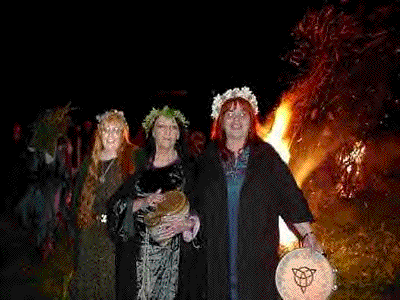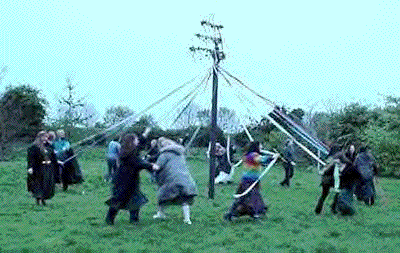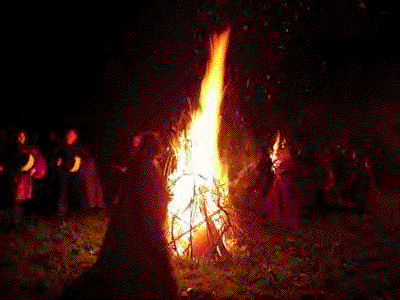Behold The Mystery | home
Beltane

Bealtaine (Beel-Teen or Bell-tayn) – called Beltane in England and Wales and
Bhealltainn in Scotland – falls opposite Samhain on the Wheel of the Year.
These were the two most important Sabbats on the Celtic calendar, marking
the beginning and end of the two recognized seasons.
Even though this is a fertility Sabbat, one that celebrates life above all,
some scholars believe the holiday takes its name from the Irish death god,
Beltene. Another possible derivative of the name might be from the Welsh god
Beli, but he appears to be more of a sun deity like Lugh, who would be
honored at Midsummer or Lughnasadh rather than in the spring. Other
intriguing possibilities of the origin of the name are from a little-known
Celtic fire god from Gaul called Belanos or Belios, or from the Phoenician
vegetation god Baal, a deity demonized by the new religion.
Still another explanation – and probably the most popular with pagans – is
that the Sabbat’s name is derived from a word meaning “balefire”. Even
today, balefires are lit all over Britain and Ireland on May Eve, just as
they were in the past. In the times of the High Kings of Ireland, it was
illegal to light a balefire until the king had lit the one atop Tara, the
seat of government. Many other cultures also sought out high spots for their
ritual fires, including the people of the Alps and of Germany. The Royal
Family of Britain still burns their Bealtaine balefire each May Eve in order
to keep the family line going.
|
The Russian tradition requires that everyone wait until moonrise to ight
balefires rather than lighting them at sundown on April 30. They toss holly
sprigs into the fire, perhaps in deference to the soon-to-return Holly King.
They also toss aromatic herbs onto the coals to make a ritual incense for
the occasion.
An old Swedish custom states that the balefire has to be lit by two people
striking two flints together. This is symbolic of the sexual union of the
Goddess and God.
In Norway the balefires are called Balder’s Fires in honor of their own Sun
God. Old brooms were often thrown upon these fires and new ones, made during
winter, were brought out and dedicated to their proposed purpose.
Germanic and Dianic covens celebrate Bealtaine as a Night of the Dead, and
ancestors are asked to join them at the warmth of the fire in much the same
way the Celts do at Samhain.
In Slavic countries, young men travel from house to house just before
sundown, to collect items to fuel the balefire. In this tradition, wreaths
are tossed into the flames by individuals who wish for healing.
In Scotland, the balefires were required to be lit from another fire known
as the tein-eigin, or “need fire”, which had to be created by using the
friction of a wheel. This fire was termed a “need” because it was used
solely to cook with, and it was the only non-ritual fire permitted to burn
on this day. Starting the need-fire from a wheel was symbolic on two levels.
First of all, it was the symbolic association with the ever-spinning Wheel
of the Year on this first day of the Celtic summer. Secondly, it is traced
to a minor god of Celtic Gaul called Taranis the God of the Wheel, who was
also honored in early May.
|
It is traditional to take home a smoldering piece of the Bealtaine balefire
to bring summer blessings into your home. The first cookfires of the summer
season were once lit with part of this fire. But note that the custom asks
you to take part of the balefire home, and not ask it as a gift. There was a
strong taboo in Ireland and Scotland against giving any portion of the
Bealtaine fire. It was a basic belief of most Europeans that faeries could
not start their own fires, but must obtain them from human sources. The
Celts respected faeries, active at this Sabbat and were sure that these
Small people would come to the celebration disguised as humans to ask for a
part of the fire which when freely given, would give the faeries some
measure of power over the giver.
|

THE MAY POLE
Another custom of Bealtaine that has never died out is that of the May Pole.
In many places in Britain, Ireland, and North America, children are still
encourage to grab the white and red ribbons and dance the old Morris Dances.
In the days of the old ways, the May Pole was made from the communal pine
tree, which had been decorated at Yule, with all but its uppermost branches
now removed. The ribbons attached to its top are traditionally white and
red, whit for the Goddess and red for the God, or white for the Virgin
Goddess and red for the Mother. The May Pole is a phallic symbol
impregnating the birth canal being woven around it by the dancers. There are
two thoughts on the symbology for the white and read streamers. One is that
the red stands for the Sun God and the white for the Virgin Goddess. The
men, holding the red streamers, and the women the white, weave the birth
canal together, representing the union of Goddess and God. The other is that
the white, held by the women, stands for the Virgin Goddess, and the red,
held by the men, stands for the mother aspect. Together the men help the
virgin aspect meld herself into motherhood on the phallic pole.
The dancers then do a Morris Dance, the Anglo name for May Day dances, which
is rich with pagan symbolism. There are usually eight dancers – one for each
Sabbat of the year – paired into four couples. The dances involve moving in
circles and weaving under each other’s interlocked, upheld arms in mock
sexual unions.
|
It is not difficult, even in modern North America, to find such a
celebration going on at May Day.
If you wish to wrap a May Pole of your own, you will need a tall object to
act as a center pole, such as a branchless tree or a flag pole. If you have
neither of these available to you, you might be able to buy a large wooden
beam at a hardware store or a demolition site. In any case, the pole needs
to be at least ten feel tall. (you can hang your ribbons at the height even
if the pole you have is significantly higher) You will also need long
lengths of ribbon or cloth about two to three inches wide and at least six
feet longer than the length of your pole so you have room to work with them.
For example, if you have a ten-foot pole, each ribbon will need to be
sixteen feet long. Ask at a fabric or craft store for the type of ribbon or
cloth you need. You will also need at least seven other dancers, though
having more is fine, and bells for your heels. Celtic, Breton, or English
folk music is the best choice, but American square dance music is a good
substitute.
Hang your evenly-spaced ribbons, alternating red and white, at the ten-foot
high point on your pole. You can tack them up any way you like. Use nails,
glue, or tie them to a wreath which slips down over the pole. Drape them
downward so they flow out at even intervals from your pole.
When you are ready to begin the dance, turn on your music and have the women
take the white ribbons and the men take the red, and each stand facing their
partner. The women will stand with their right sides to the pole, and the
men will be standing with their left to the pole, the ribbon in their left
hands. Begin weaving the symbolic birth canal by having everyone move
forward from where they stand, moving alternately over and under the person
coming toward to them. It is tradition to start with the men moving their
ribbon and selves under the upheld ribbon of the women. Proceed in this
fashion until the May Pole is wrapped about eighteen inches down.
As you move to the music, make your steps a cross between a skip and a jog
so that the bells on your heels hit the ground with enough force to mark off
the beats of the music.
Many old folk song lyrics that proclaim the praises of the glorious Sabbat
survived from remote parts of Britain. Many of them have become shrouded in
arcane language over time, either deliberately or by accident, while others
are remarkably straight forward. The following is an example of this music,
the joyful lyrics of an old song from Cornwall. It is entitled simply, “A
May Day Carol”. Though the sentiments have been somewhat Christianized, they
still reflect the themes of courtship, fresh flowering, honey ale and dairy
foods, and making merry, for which Bealtaine is noted.
Awake, awake, my pretty prithy maid,
Come out your drowsy dream,
And step into your dairy hold,
And fetch me a bowl of cream.
If not a bowl of cream, my dear,
A cup of meade to cheer,
For the Lord knows we shall meet again,
To go maying another year.
A branch of May I brought you here,
While at your keep I stand
‘Tis but a sprout all budden out
by the power of our Lord’s hand.
My song is done and I must be gone,
No longer may I stary,
God bless you all, the great and small,
And send you a joyous May.
Finding the lyrics of folk music with their pagan meanings still intact is
an exciting pastime for many pagan people, and a rewarding one since it is
easy to do. As the established Church (either the Roman or the Anglican,
depending upon location) became the ruling presence in the cities and towns
of Europe, paganism was left to the countryside where often the
custom-killing hand of clerical power did not reach. For many centuries the
seasons, and it was they who preserved folk songs for us through their oral
traditions. Much of the folk music whose origins can be traced to at least
the sixteenth or seventeenth century often hints at this division of
religious life. One of the most glaring examples of this is the British folk
song, “The Oak and the Ash”, which honors three of the sacred trees of the
Celtic people, the oak, ash and ivy. The song tells of a north country girl
(most likely meaning she is from Yorkshire) who has gone to London and
misses her homeland with all its attendant customs. The chorus of the song
is “… Oh, the oak and the ash and bonnie ivy tree / They flourish at home in
my own country”.
Bealtaine circles were once constructed with the May Pole at the center and
a balefire at a distance, at one or all four of the cardinal points. The
altar was lavishly decorated with fertility symbols such as holy stones,
geodes, pine cones, flowers, and spring-time greenery. The rituals were
erotic in nature, symbolizing the union of the Goddess and God.
|

BEALTAINE SOLITARY RITUAL
For this ritual you will need to have on hand your usual ritual tools, and
some spring flowers. Having a chaplet of flowers for yourself is optional.
(When you are ready to begin you should cast your circle, call your
directional energies, and invite your deities)
Blessed be this day of Bealtaine,
Wedding day of the Goddess and the God.
Holy day of sacred marriage, holy night
Of sacred union
(Some traditions insist that a pagan working alone cannot properly perform
the Great Rite. Since the act is a symbolic one, there is no reason you
cannot make it part of solitary worship. Take your athame in your right
hand, and your chalice in the left. Hold them in front of you. See them as
the earthly vessels of deity.)
Tonight I witness the marriage of my Goddess and God. May the union be
fruitful.
(Place the athame inside the chalice and feel the union of the deities)
As they are one, they become one.
As they become one, they are one.
As I, too, am one with them.
(Raise the athame and chalice, still united, to your forehead to honor this
union of the three of you. You may also now crown yourself with the chaplet
of flowers. This will signify that ou are a Queen or King, just like the
deities with whom you have joined. Take some of the flowers from the altar
and dance with them. They are manifestations of the union of the deities. If
you follow the Greco-Roman tradition yo may want to offer your praises to
Flora, the Goddess of the Flowers. When you are finished you may close the
circle in whatever manner you choose.)
The Circle is open, but unbroken.
Blessed be.
|
